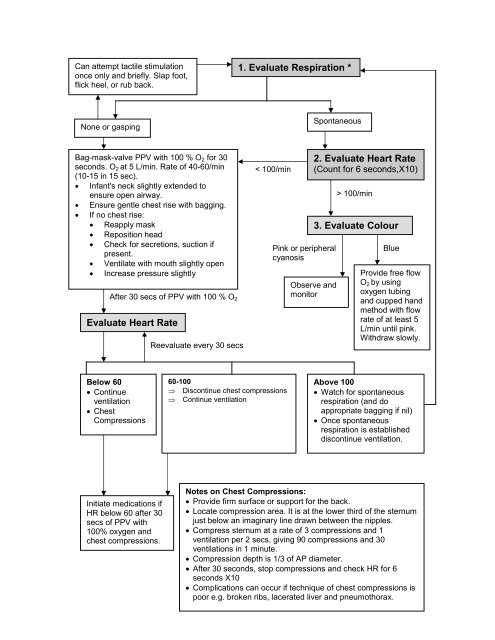Contents Chapter Topic Page Neonatology Respiratory Cardiology
Contents Chapter Topic Page Neonatology Respiratory Cardiology
Contents Chapter Topic Page Neonatology Respiratory Cardiology
You also want an ePaper? Increase the reach of your titles
YUMPU automatically turns print PDFs into web optimized ePapers that Google loves.
Can attempt tactile stimulation<br />
once only and briefly. Slap foot,<br />
flick heel, or rub back.<br />
None or gasping<br />
Bag-mask-valve PPV with 100 % O2 for 30<br />
seconds. O2 at 5 L/min. Rate of 40-60/min<br />
(10-15 in 15 sec).<br />
• Infant's neck slightly extended to<br />
ensure open airway.<br />
• Ensure gentle chest rise with bagging.<br />
• If no chest rise:<br />
• Reapply mask<br />
• Reposition head<br />
• Check for secretions, suction if<br />
present.<br />
• Ventilate with mouth slightly open<br />
• Increase pressure slightly<br />
After 30 secs of PPV with 100 % O2<br />
Evaluate Heart Rate<br />
Below 60<br />
• Continue<br />
ventilation<br />
• Chest<br />
Compressions<br />
Initiate medications if<br />
HR below 60 after 30<br />
secs of PPV with<br />
100% oxygen and<br />
chest compressions.<br />
Reevaluate every 30 secs<br />
1. Evaluate Respiration *<br />
< 100/min<br />
60-100<br />
⇒ Discontinue chest compressions<br />
⇒ Continue ventilation<br />
Pink or peripheral<br />
cyanosis<br />
Spontaneous<br />
2. Evaluate Heart Rate<br />
(Count for 6 seconds,X10)<br />
Observe and<br />
monitor<br />
> 100/min<br />
3. Evaluate Colour<br />
Blue<br />
Provide free flow<br />
O2 by using<br />
oxygen tubing<br />
and cupped hand<br />
method with flow<br />
rate of at least 5<br />
L/min until pink.<br />
Withdraw slowly.<br />
Above 100<br />
• Watch for spontaneous<br />
respiration (and do<br />
appropriate bagging if nil)<br />
• Once spontaneous<br />
respiration is established<br />
discontinue ventilation.<br />
Notes on Chest Compressions:<br />
• Provide firm surface or support for the back.<br />
• Locate compression area. It is at the lower third of the sternum<br />
just below an imaginary line drawn between the nipples.<br />
• Compress sternum at a rate of 3 compressions and 1<br />
ventilation per 2 secs, giving 90 compressions and 30<br />
ventilations in 1 minute.<br />
• Compression depth is 1/3 of AP diameter.<br />
• After 30 seconds, stop compressions and check HR for 6<br />
seconds X10<br />
• Complications can occur if technique of chest compressions is<br />
poor e.g. broken ribs, lacerated liver and pneumothorax.
















